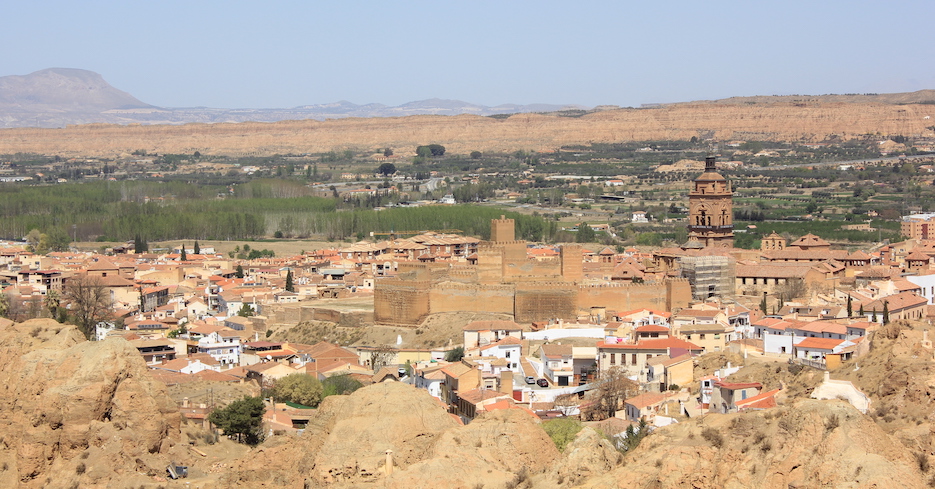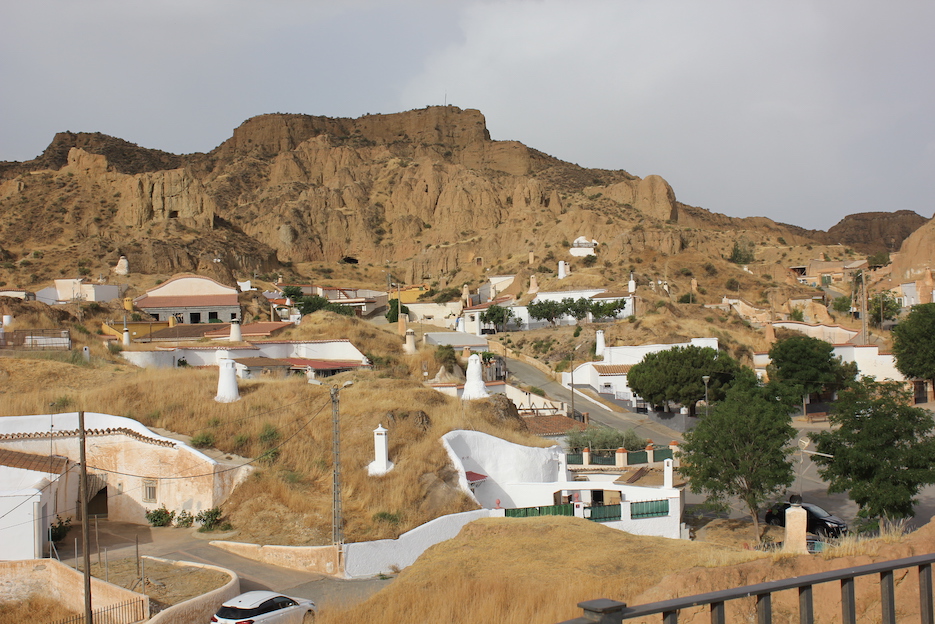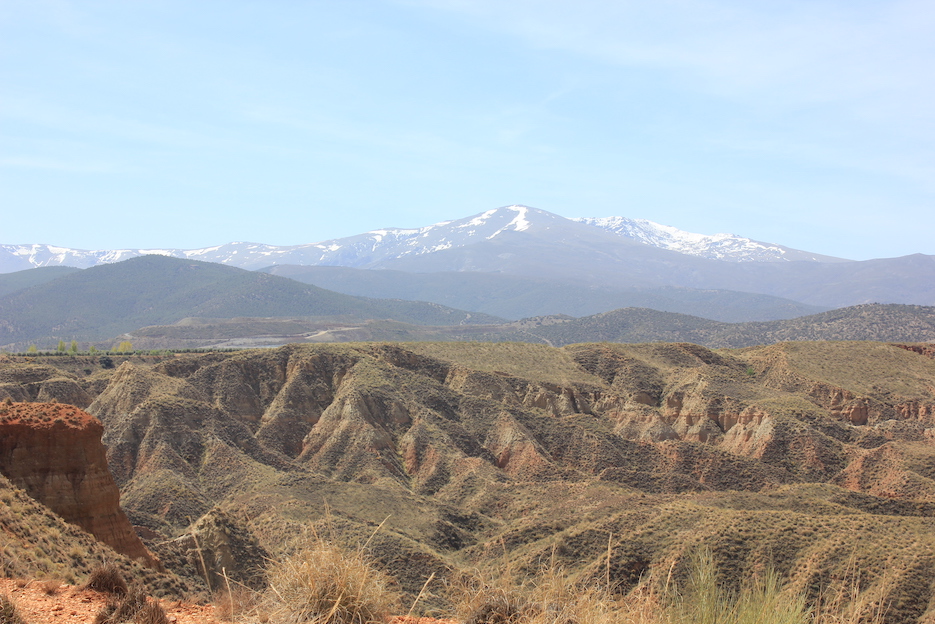Interesting places:
Guadix, Geopark Granada
Caminito del Rey
Guadix, Geopark Granada
60 km from Granada, 140 km from Salobreńa and Motril Guadix, a small Andalusian town (around 25,000 inhabitants) is a well-known tourist destination. Tourists are attracted by the charm of the historic town, but the town’s best-known attraction is the inhabited district of houses carved into the rocks. The city lies at the foot of the Granada Geopark, famous for its unique nature and extraordinary views. The Sierra Nevada mountains, a short distance from the city, also provide a beautiful panorama.

Guadix panorama
Guadix
is one of the oldest human settlements in Spain. It was an important Roman colony, called Julia Gemella Acci, and one of the first Christian dioceses in Spain. Under Muslim rule, the city acquired the Arab urban layout, which still prevails in some streets. In the 11th and 12th centuries, Wadi Acci became together with Baza, one of the most flourishing taifas (small kingdoms) in Al-Andalus, which disappeared due to the fundamentalist Almohad movement. The famous writer Pedro Antonio de Alarcon was born in Guadix in 1833. Two of his works were related to this town: El Niño de la Bola and El Sombrero de Tres Picos. There is a statue of Pedro in the main square. The Palacio de Marqueses de Peñaflor has a room dedicated to the writer.

In Guadix we will see, among others:
The cathedral
underwent a complex construction process beginning in the 16th century and ending in the 18th century. It was built on the site of the great mosque and is a blend of the Gothic, Renaissance and Baroque styles. The end result of Guadix Cathedral is a church with a nave and two aisles on a Gothic quasi-basilica floor plan, with a beautiful ambulatory and numerous side chapels. It has three façades, with the main one being dedicated to the Incarnation.
It comprises no less than 47 oil paintings on canvas dating from the 17th and 18th centuries.

Alcazaba: Historic monument built in the 11th century, it is the best example of Moorish culture in Guadix. The
Seminary: founded in 1595, one of the oldest in Spain. The Seminary is built around two courtyards. The Palace of Peñaflor ( 17th and 18th centuries ) it shows how some noble families left their mark on the city. It has a central courtyard and a magnificent balcony.
Barrio de Santa Ana: a very important area in the Islamic period, it was an independant suburb of the Medina. As is often the case, the church is in the centre of the district.

Barrio de Cuevas The local Guadix environment has left its mark on the way of life of the local population, forcing them to construct a peculiar type of family and communal dwelling: caves.The exact date when the caves began to be used as a living space is unknown, but it is presumed to be some time after the Islamic period. Construction was in full swing by the first half of the 16th century. At the present there are around 2000 caves, inhabited by some 3000 people, the largest cave complex in Europe.

The Granada Geopark

The Granada Geopark, declared a World Geopark by UNESCO in 2020, has 4,722 km2 of 47 municipalities belonging to the regions of Guadix, Baza, Huéscar and Montes, it extends over an exceptional territory in the central sector of the Betic Cordillera surrounded by some of the highest mountains in the Iberian Peninsula, such as the Sierra de la Sagra or Sierra Nevada. Here we find most unique landscapes: a semi-desert featuring a succession of tens of thousands of gullies and badlands surrounded by mountains and the peaks of the Sierra Nevada. The Granada Geopark is one of the few natural deserts in Europe.

After tens of millions of years spent forming part of ancient seas, the land emerged and was transformed into a huge enclosed depression surrounded by mountains. A dense network of streams and wadis collected the rainwater, which, with no outlet to the sea, accumulated in a lake that was located towards the area of Baza. This process continued for hundreds of thousands of years and the great depression slowly filled in with sediments in the form of layers of sand, silt and clay, and gypsum.
The Granada Geopark offers a journey to the Quaternary period and to Prehistory, where you can learn about extinct fauna, the first hominids to reach Europe and the environment in which they lived, visit an exceptional concentration of dolmens from 5,000 years ago, The Granada Geopark has more than 70 sites of geological interest. In addition, there are iconic landscapes that simply must be visited, such as the Mirador del Fin del Mundo, the viewpoints of Marchal and Purullena, and Los Coloraos.
A great experience is an hour-long cruise in a heated air balloon. The balloons take off from Guadix, the hour-long cruise takes place over the town and the Geopark.


Our tours
We propose private excursions to see the sites described above, namely the Old Town of Guadix, the rock house district and the Granada Geopark. Those who wish will be able to take a balloon flight. Excursion The Geopark Granada, Guadix Distance round trip – 300 km. Group: 4 persons
Details: https://www.facebook.com/profile.php?id=61555252727786
Program Departure (pick-up Motril, Salobreńa, Almuńecar) – 9.00 Granada Geopark - the Mirador del Fin del Mundo, the viewpoints. (about 1 hour) A trip to the big city market. It is organised on Saturdays. Shopping opportunity. Walk and visit the house-cave district. (about 1,5 hour). Walking city tour. Visit cathedral, Roman ruins, Moorish castle, old town. (about 2 hours) Free time (1 hour) Lunch break – time to be agreed.
The activity consists of the balloon flight and includes a local breakfast and a souvenir certificate. This flight takes place in a spectacular landscape conquering heights above 2,000 meters or with low flights. With Sierra Nevada as a backdrop, the tour allows you to admire the cathedral of Guadix, citadel and the neighbourhoods of the cave houses. Program Departure (pick-up Motril, Salobreńa, Almuńecar) – 6.30
Caminito del Rey
Caminito del Rey, excursions, Malaga, Andalusia
The most spectacular routes in the world!
The Caminito route is spectacular from beginning to end, the scenery is breathtaking and unforgettable.
The path is approximately 8 kilometers long and takes roughly 3 hours to complete. It is not for the faint- hearted and is not a tour for people who have issues with height.
This almost 8-kilometre path near Malaga (Andalusia) was once considered one of the most dangerous in the world. Today the entire route has been carefully restored, but although it’s now much safer, one thing hasn’t changed - the unique experience of strolling along walkways hanging over 100 metres up on a sheer cliff face. The Caminito del Rey running through cliffs, canyons, and a large valley. It crosses the landscapes of Desfiladero de los Gaitanes, a gorge carved out by the river Guadalhorce, with walls 700 metres high. The area is also inhabited by a wide variety of plant and animal species; with a little luck, you can see highland birds like Egyptian vultures, griffon vultures, or golden eagles, and mammals such as wild boar and Iberian ibex.
Official website:
https://www.caminitodelrey.info/en


caminito
photos: Andalusian.org
Excursions
Join us for a walk through the mountains through the unique king’s little pathway along the steep wall of the narrow gorge of El Chorro. 3 hr 30 min, cost 59,50 EUR Included:
- Pick-up & Drop off with private transportation.
- Excursion Manager
- Entry to the Caminito Del Rey Excursion pick-up locations: Motri-Salobrena-Amunecar-La Herradura-Nerja-Torrox. ( We will contact you to arrange your nearest pick-up location).
https://www.andalusianexcursions.com/

photo: Andalusian Excursions
